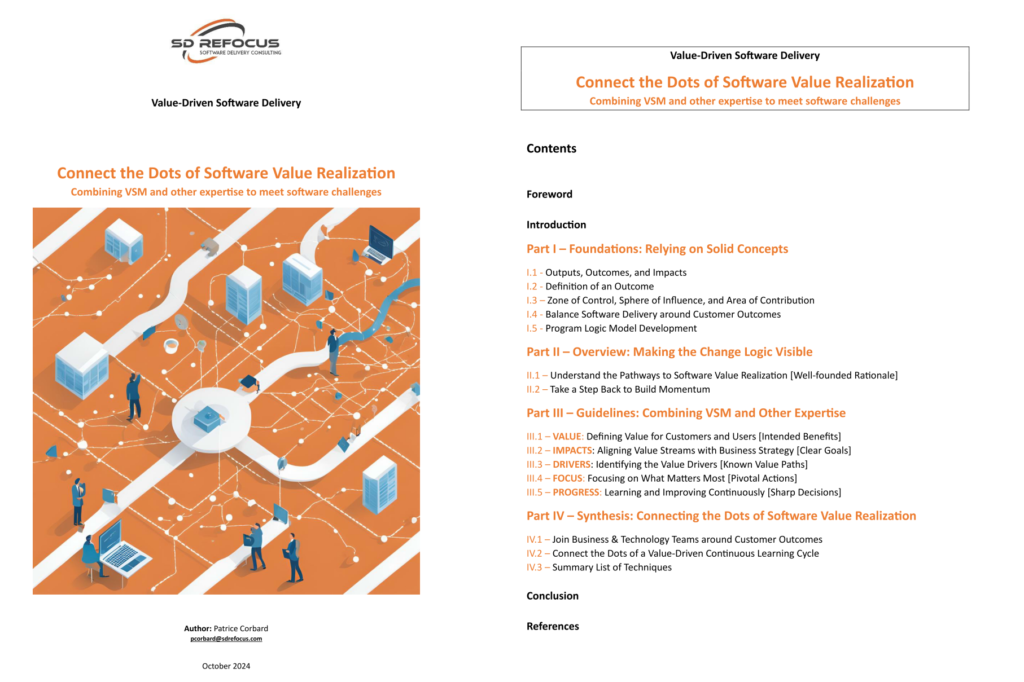Connect the Dots of Software Value Realization
October 2024 - It has been almost a year since I began sharing value-driven news, insights and knowledge about our quest for value on LinkedIn and at sdrefocus.com. I am pleased to announce that I have now reached a point where I can present a synthesis of all this work.
The maturation process has been a lengthy one, and it is my hope that the result will be fine wine, rather than old milk. In summary, the objectives of clarity and simplicity are difficult to attain in our areas of expertise, where misunderstandings and confusion still abound in our feeds.
Albert Einstein would have articulated this concept with great eloquence (*). From my experience as a consultant and trainer, I have learned that it is crucial to have a solid grasp on the concepts before being able to provide guidance on their implementation.
What is the primary objective here? It is simply an outside-in approach, beginning with a refocus on the purpose of value realization (the "why") and then connecting the dots on the capabilities to achieve it (the "what" and "how").
The good news? Without exception, all the communities I've visited so far on my journey are working towards the same goal of maximizing value:
In alphabetical order, and I'm probably forgetting some: agility, customer experience, DevOps, enterprise architecture, IT management, Kanban, lean management, OKR, product management, team topologies, value management, and of course value stream management.
The intent is to establish a coherent and simple synthesis of these skills without reinventing the wheel. I must acknowledge that I have identified numerous elements that were previously unknown to me. Some even date back several decades!
I believe that my experience is not unique. I have not had the opportunity to take advantage of this proven knowledge due to a shortage of time. It is easy to become distracted by the demands of our work and miss out on valuable learning opportunities.
While some frameworks are positioning themselves as integrators of these disciplines, I think it is essential to maintain an independent vision, above the usual disputes. The integration of these concepts is already a challenging process; it is therefore important to avoid the additional complication of being influenced by the profitable business model of certification and re-certification.
This article provides an overview of the key features of an upcoming e-book and its accompanying toolkit.
Please be advised that the following extracts are neither exhaustive nor perfect. Instead, they present a synthesis of insights derived from my own research and experience. I look forward to continuing to learn with my customers and to developing these assets in line with their needs.
(*) “If you can't explain it to a six-year-old, you don't understand it yourself.” – Albert Einstein
A Context of Ever-Increasing Challenges, Demands and Threats
The stakes involved in software success are becoming increasingly high, and the consequences of software failure are more serious than ever. The worldwide CrowdStrike outage in July exemplifies this phenomenon. Teams responsible for designing, developing, testing, securing, and operating software products are subject to ever-increasing demands and threats, within tight deadlines and budgets. Effective management of these pressing challenges is therefore essential.
In addition to these challenges, we continue to face critical organizational issues, including lack of a clear strategic direction, mismatches between strategy and execution, uncertain priorities, low transformation success rates, fatigue caused by frequent reorganizations, and significant talent shortages.
These problems are significant and require a systemic approach to correcting overall operating conditions. A multitude of uncoordinated local optimizations will not suffice.
Towards Value-Driven Software Delivery
« Our highest priority is to satisfy the customer through early and continuous delivery of valuable software »
Manifesto for Agile Software Development, 2001
Let's begin by acknowledging the continued relevance of the Agile Manifesto's first principle. Despite occasional criticism, the agile and DevOps movements are making valuable contributions to the field. Even if only partially or imperfectly implemented, these transformations enable teams to make progress in the right direction. Developments are typically carried out in short, incremental iterations lasting a few weeks. The close collaboration between development and operations teams fosters accelerated software deployment rates and facilitates the rapid collection of end-user feedback. The highest-performing organizations are now capable of continuously delivering software releases (up to several times a day, if necessary), whether to add new features, fix bugs, or rapidly resolve security vulnerabilities.
It is important to maintain an objective assessment and recognize that an increase in technical capabilities does not necessarily lead to an improvement in customer satisfaction. Additionally, industry reports indicate that only a limited number of organizations have attained these advanced levels of capability. The CrowdStrike outage is also a powerful reminder that it can be dangerous to focus too much on speed and take shortcuts when it comes to system reliability and resilience.
Both the Agile Manifesto and the Scrum Guide place an emphasis on value delivery objectives, yet neither provides concrete guidance on how to achieve this. The absence of precision could be justified if the concepts were inherently self-explanatory and therefore did not necessitate further definition. Nevertheless, in practice, generic terms and objectives are often found to be inadequate. The consequences of this vagueness can be seen at all levels of the organization, including unclear corporate strategy, dispersed initiatives, overloaded teams, conflicting priorities, guesswork decisions, and unrealistic target setting.
How can we achieve the first principle of the agile manifesto? How can we eliminate the silos between business and technology teams and move beyond the customer-supplier mode? How can we manage activities based on the value to be delivered, rather than on the completion of endless lists of tasks? How can we connect improvements in our ways of working to the dual objectives of customer-centricity and corporate results?
Our newsletter "Value-Driven", published monthly, confirms that business and technology leaders can draw upon a wealth of know-how to master software developments and deliver greater value. These practices, which are sometimes little-known, are scattered across a multitude of disciplines, specialties, and communities.
Our work applies the principles of Lean Thinking to recommend a value-driven approach to improvement. This begins with clearly defining the expected value. By adopting a Value Stream Management (VSM) approach that harmoniously combines other elements of existing know-how, it is then possible to connect the dots of software value realization.
The Need to Build on Solid Foundations
The objectives and expected results are frequently unclear and difficult to pursue, let alone to measure in concrete terms. If the concepts of value are not clearly defined and based on sound principles, the entire approach is flawed and will inevitably fail.
It is therefore essential to move beyond the vague and imprecise terms of value and result, and focus on the core issues. What types or elements of value are we talking about, and, most importantly, for whom? How can we bring together a group of people around shared ideas that connect their legitimate perspectives?
Fortunately, there is a wealth of expertise available to assist with this, but it remains largely unknown. The first ones I've selected clearly distinguish the results of our activities into three types: outputs, outcomes and impacts.
The key to success lies in linking these three types of result in a multiplier effect, rather than seeing them in opposition to one another as in the traditional view. If employees are happy and focused on producing outputs that drive customer outcomes, this increases the likelihood of generating positive business impacts for our organization.
All three dimensions are essential and interrelated, and depending on the circumstances, we place varying degrees of emphasis on each. If an excessive amount of emphasis is placed on one dimension to the detriment of the other two, the system is no longer viable in the long term.
While the three types are closely linked, customer outcomes are of particular importance. In fact, we oscillate between the three dimensions, with a balance point centered around customer outcomes:
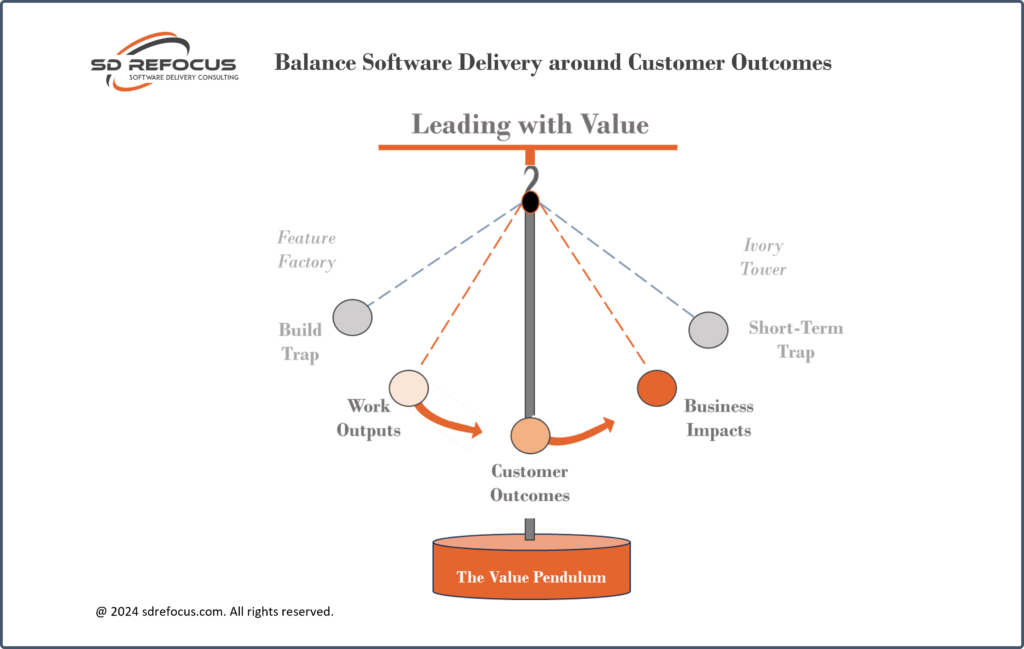
If the balance is disrupted by internal strategic or engineering considerations, the company may fail to meet its customers' expectations over the long term.
Managing software delivery is a balancing act! You have to keep an eye on the big picture to avoid falling into the usual traps of an unsustainable "Feature Factory" or a short-sighted "Ivory Tower."
Six Key Questions to Help You Get Started
Q1- CHANGE: How are our transformations supposed to generate the beneficial changes we hope for?
Pains: No clear link between our work and the intended results.
Gains: Well-founded rationale, greater buy-in.
Your level of confidence? Low - Medium - High
We can leverage the expertise developed in the field of social and environmental programs to build our understanding of the pathways to software value realization.
A Logic Model is the foundation for understanding the causal relationships between our activities, work outputs, changes in customers & users experience (outcomes), and contributions to achieving the company's strategic business goals (impacts). These models provide a clear rationale for proposed interventions, enabling investors to fund change initiatives:

Source: « Logic Model Development Guide » by W.K. Kellogg Foundation, 2004
We strongly recommend that you begin with collaborative workshops to discuss the rationale for the envisioned changes. These workshops are essential for building momentum and breaking the status quo of "we've always done it this way."
Q2- VALUE: Does our work bring value to our customers and users?
Pains: Unclear direction, distance from customer concerns.
Gains: Customer-centric intended benefits.
Your level of confidence? Low - Medium - High
In alignment with the tenets of Lean Thinking, start with gaining a clear understanding of what your customers value. In fact, it's all about clarifying the value proposition for different customer segments or profiles with their jobs, gains and pains.
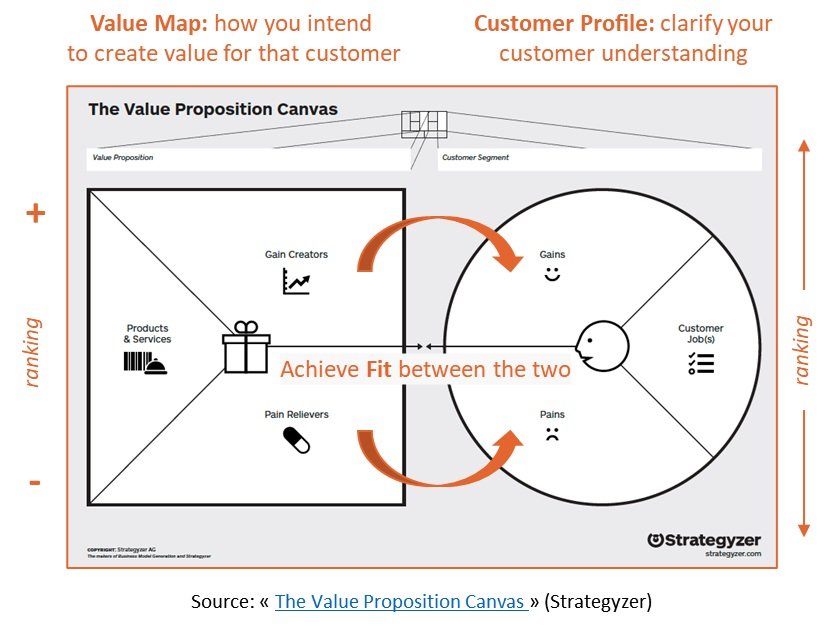
The next step is to identify the elements of value (gain creators and pain relievers) that matter most to your customers.
To succeed, you must continuously adapt and adjust the market fit of your products and services to align with your customers' evolving expectations.
Q3- IMPACTS: Are we contributing to the company's strategic goals?
Pains: Disconnects between strategy and operational execution.
Gains: Clear alignment with corporate goals.
Your level of confidence? Low - Medium - High
In addition to clarifying the benefits we offer our customers; we must ensure the economic viability of our business by establishing a clear and aligned vision of strategic goals.
It is the responsibility of executives and leadership teams to set the long-term direction, communicate it, and ensure that everyone is aligned with the company's strategic priorities.
A recommended way of doing this is to define OKRs (Objectives and Key Results) expressed in terms of customer outcomes and business impact for the company, and not as a traditional list of activities producing outputs.
The identification and organization around value streams must also be aligned with our business goals.

Q4- DRIVERS: What customer behaviors drive our business results?
Pains: Ignorance of what drives our success.
Gains: Known Value Paths.
Your level of confidence? Low - Medium - High
While the two previous challenges—clarifying customer value and the company's strategic objectives—may not be immediately apparent and are often overlooked, this one is of paramount importance for the company's or product's survival.
The aim here is to develop a detailed Logic Model that enables us to understand both links:
- between customer experience and business impacts, for instance by defining a North Star Metric;
- between our capabilities and customer experience changes, leveraging industry knowledge like the State of DevOps reports from DORA Research:
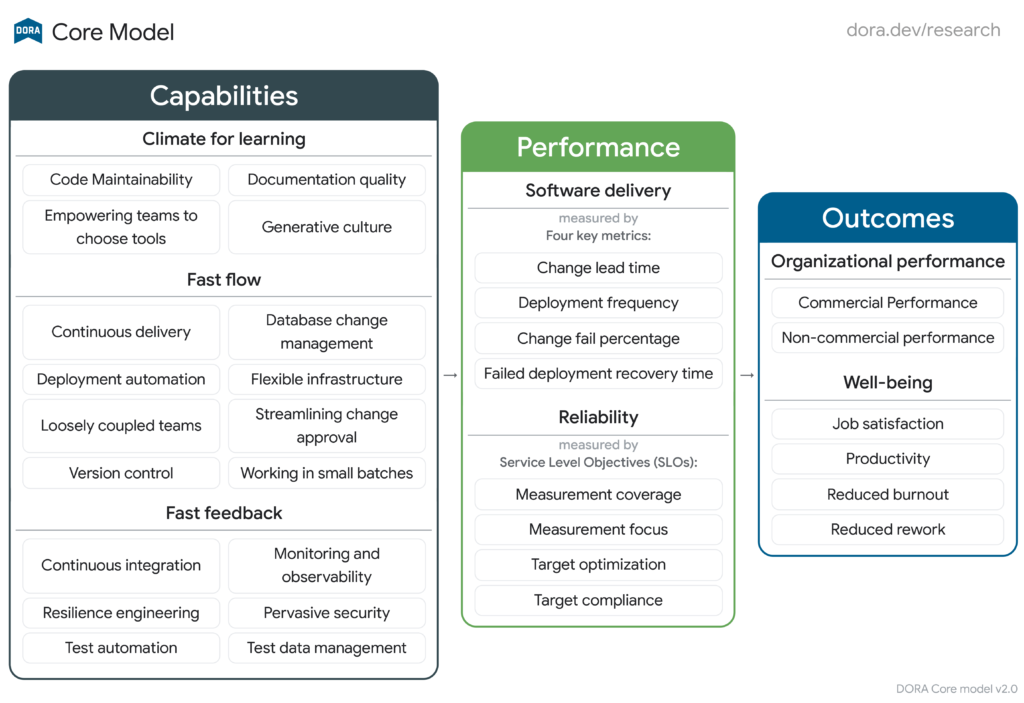
Source: « DORA Core Model » by DORA Research, 2024
Q5- FOCUS: Where should we focus our capabilities and improvements?
Pains: Disruptions and distractions between all the activities to be carried out.
Gains: Carrying out pivotal actions.
Your level of confidence? Low - Medium - High
The previous elements set out the priority directions we should be pursuing. To focus our energies on what matters most, we need to make operational decisions based on these orientations. We must decide on the activities to be carried out on the product and the improvements to be made to the operating model.
To be able to focus on worthwhile improvements, it is essential to visualize the efficiency of the entire workflow and understand its effectiveness in delivering the intended value. Collaborative Value Stream Mapping workshops are essential techniques for achieving this.
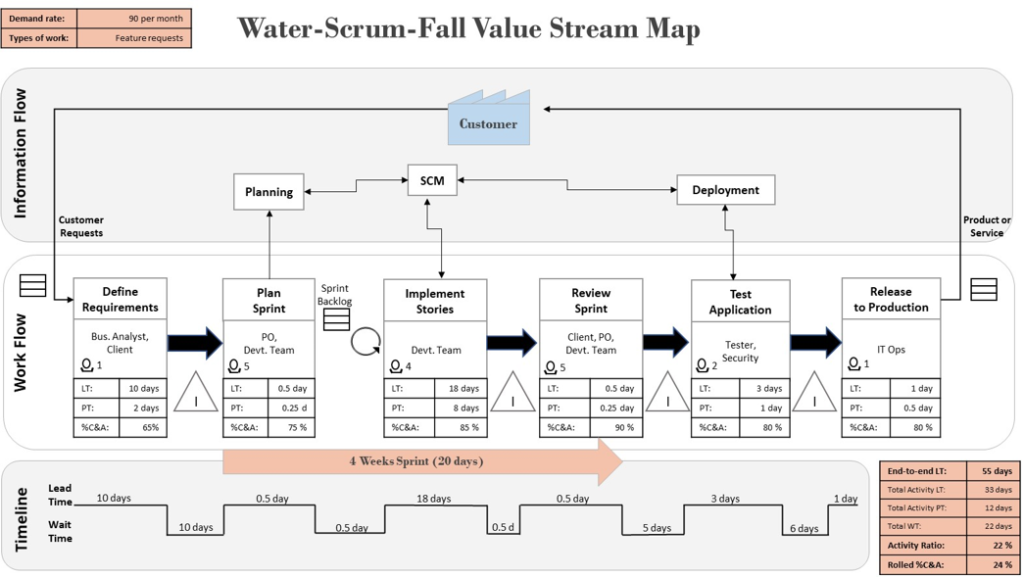
See our whitepaper: “Value Stream Mapping for Software Delivery”
Q6- PROGRESS: - Are we making measurable, tangible progress?
Pains: Inability to show progress.
Gains: Making sharp decisions.
Your level of confidence? Low - Medium - High
Measurements support the company's culture of learning. They help business and technology leaders make sharp decisions about how to maximize value.
Get a complete view of your end-to-end flow of value, combining strategy, product, engineering, flow, customer and business metrics using Value Stream Management Platforms (VSMPs) and Kanban boards.
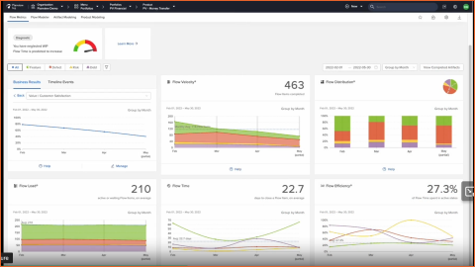
Source: Planview VSM Online Demo
What's Next?
How would you rate your confidence in answering the six questions above?
If you're interested in these first extracts, contact me now to find out more about the upcoming e-book, the twenty or so techniques referenced in the accompanying toolkit, or simply to book an appointment.
